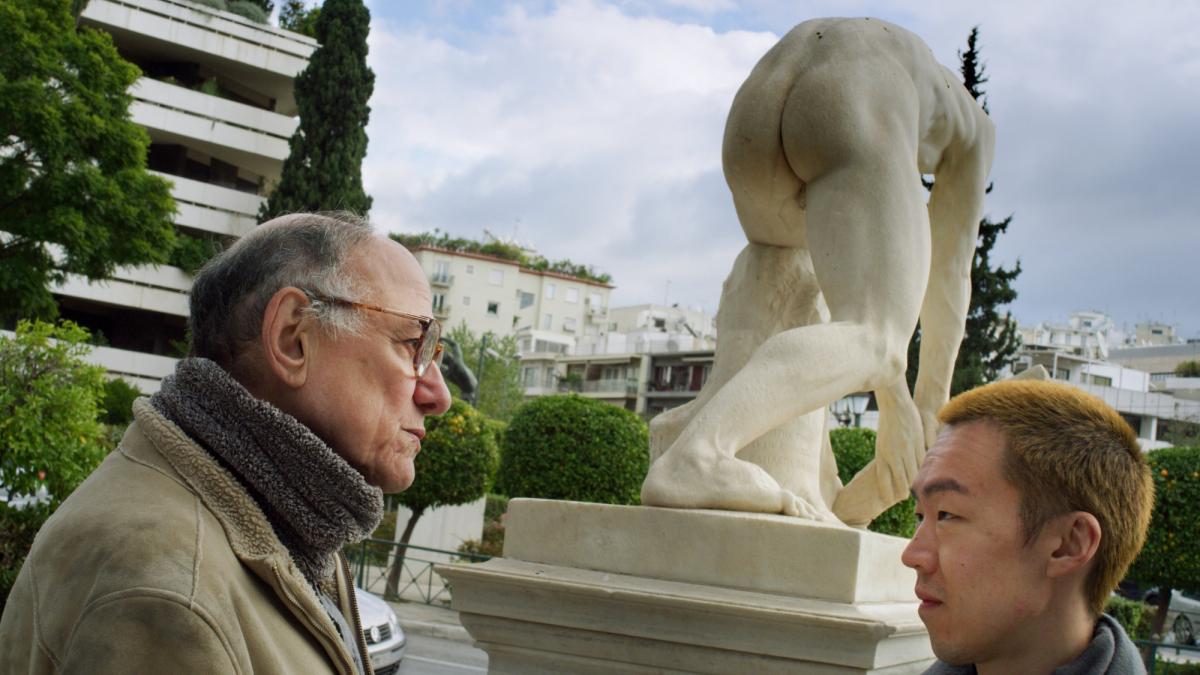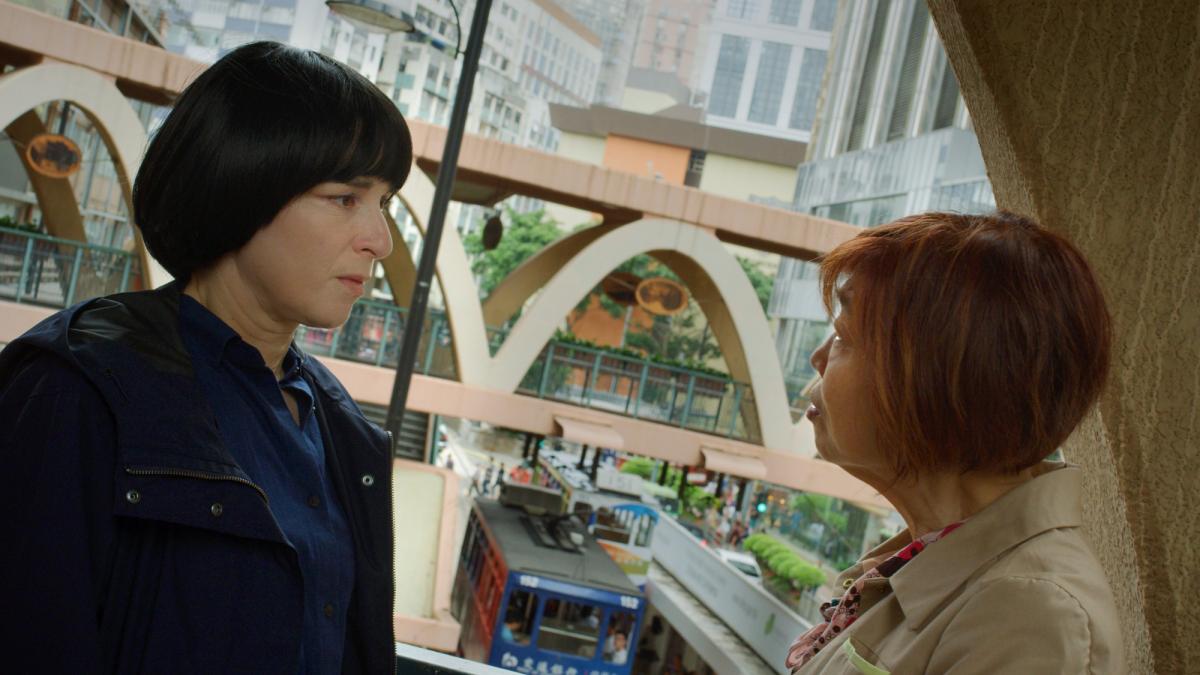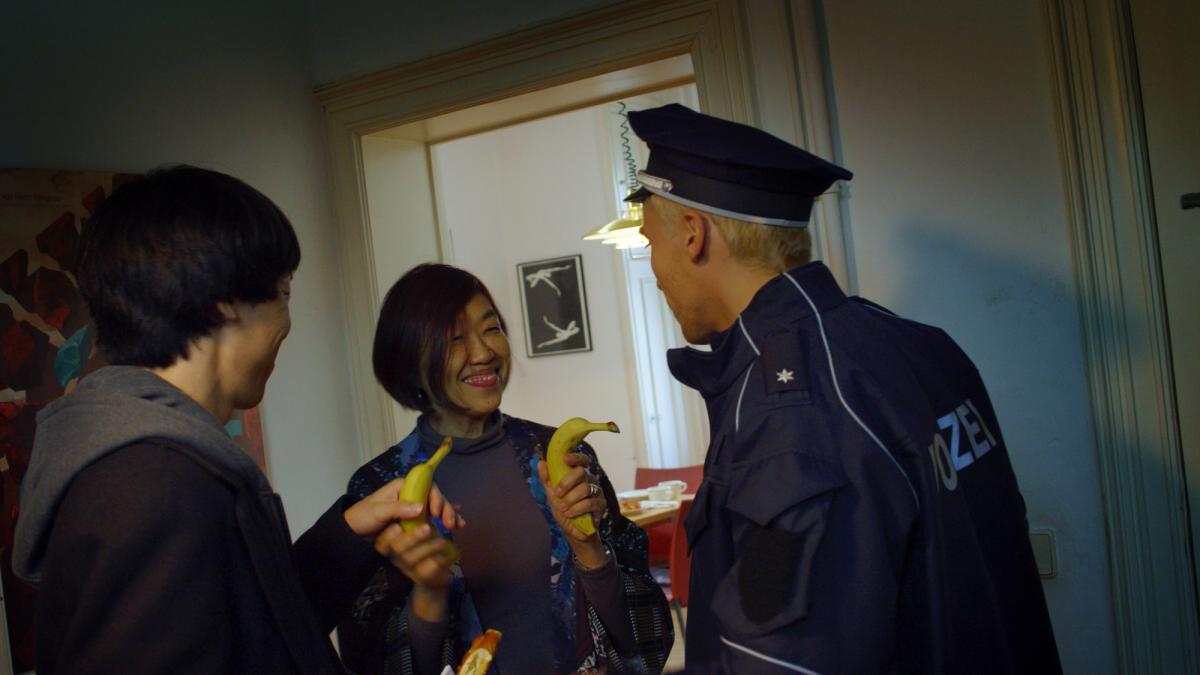Sculptures in Time
A Conversation with Heinz Emigholz
The veteran filmmaker Heinz Emigholz is probably best known for his one hundred architectural films without people or voices. In The Last City (2020), he returns to narrative filmmaking after twenty-five years. The result is an irreverent mix of the casual and perfectionist, the absurd and the confessional, a handmade, queer set of collisions.
The film starts with an archaeologist and a weapons designer – who, in a prior life, knew each other as a filmmaker and a psychoanalyst – meeting at an archaeological excavation site in the Negev Desert to discuss love and war; a conversation they continue in the Israeli city of Be’er Sheva. The film then proceeds with changing actors in changing roles; a round dance (like in the famous film by Max Ophüls) that takes us to the cities of Athens, Berlin, Hong Kong and São Paulo. These dialogues deal with now obsolete social taboos, generational conflict, war guilt and cosmological musings. The architecture of each of the five cities serves as the third participant in the protagonists’ dialogues and completes their philosophical and metaphysical journeys. All this is staged with Emigholz’s ever-inventive eye, for a camera which he operates himself, with his now iconic use of the Dutch tilt and meticulous, often humorous framings and a masterful response to places and light.
It’s an important film which restates the commitment Emigholz made in the 1970s to a rich, heterogeneous kind of filmmaking, which refuses the simple opposition between formalist/structural concerns and the staging of voices, bodies and stories. In recent years, we’ve seen this often political distinction collapsing within experimental filmmaking. Given that The Last City still hadn’t received a premiere in the UK, I decided to screen it in Glasgow, as part of Inclinations Film Club, a regular event we host at the Centre for Contemporary Arts. For that audience and the readers of Sabzian, Heinz Emigholz kindly offered some words on his films and working methods, in particular relating to his narrative works.

Rastko Novaković: I’d like to talk to you about The Last City (2020). You’ve spoken about how long you’d lived with the idea of this film and the first failed attempt to raise funds for it. It feels like a first and last film, first because you are trying new things and last because you’re folding so many of your interests in and drawing a line under it all. How do you feel about it now with a bit of distance and what did you find in making this film that you’ve continued to work on?
Heinz Emigholz: The plan for a film called Tale of Five Cities goes back to the early 2000s, the young Moroccan producer Karim Debbagh wanted to produce it. I had planned to do five separate acts in the cityscapes of Fez, Kashan, Rome, Tel Aviv and Houston, Texas: a clash of ancient and modern architectures, experienced by a symbiotic couple, a blind guy and a deaf guy, with always changing sociological backgrounds. More or less an essay film about all kinds of breathing, all stages of love, including one supernatural digital SFX-event and one poem by Kafavis in each city. Remnants of these ideas you can still find here and there in The Last City, but the core of Tale of Five Cities were still five conventionally straight forward told stories. My breakdown described in Streetscapes [Dialogue] that consequently led to the double-helix or double-bind structure of The Last City lay still in the future, let alone my complete loss of interest in SFX. You’re right, it was a “first” film completely relieved of narrative constraints, and a “last” film in regard to final statements about certain main topics I wanted to deal with, as there are war, social taboos, generational conflicts, guilt and cosmology. The Western avant-garde’s general ban against narration was broken by developing a new kind of narration. Which was only possible with a new understanding of cinematography and of the camera as a third protagonist. I practiced it before, but now I understood, and the block against narration disappeared in view of a vast realm of new possibilities.
In Normalsatz (1982) you were already having two places (Brooklyn and Hamburg) become one (Brookburg) through a tapestry of shots and a mixing of German and English. In The Last City, one person is played by two people at the same time and the same actors play two different characters. It seems like your visual approach to an object or person is analogous to your approach to aspects of narrative, like place and character.
Normalsatz for me now feels more or less like a documentary film about a science-fiction-like state of the gender-, race- and continuity-agnostic being we were involved in. And it was the first proof of a new kind of cinematography in a narrative context. It felt like living in a spaceship where narrative gravity would be nothing less than absurd. Frieda Grafe grasped that immediately after seeing the film at the Berlinale in 1991: “Images with words and sentences open up new vistas for the eyes and ears. One truly perceives without the additional constructs that are introduced in the media of thought and art. It is as if Einstein had run rampant in the film. Or as if a traveller to the moon were looking down at the earth. Or to put it more simply and closer to home: Imagine the impression that the guests of Gertrude Stein would have had when they saw the first Cubist paintings hanging unframed on the walls of her studio.” Others condemned the film as petty-bourgeois flaneurism. Those were the days of self-righteous political film commentators.
The Last City feels different, like the seventies features were driven by the images and situations, with little stories coalescing, but here there is an intricate set of stories told through these intense exchanges. The dialogue is this relentless, continuous texture. Narrative is an absurd locomotive. Why so little silence?
I’ve had it with silence, and I find silence boring and dubious as a dramaturgical device within traditional filmmaking. More than a half of my one hundred or so films have no dialogue at all. They’re not “silent”, but in a strict sense about what has to be done there was no need for dialogue. And there will be more of those films. But language has its own rights. The sense it can make was new to me, starting with Demon (1977) on an atomic level. First came the word, then the sentence, then the paragraph, and then the world of a whole context. If you don’t use the camera in an illustrative way and keep it working in its own rights the locomotive speech does not disturb but creates its own universe. Two universes simultaneously.
In your film The Meadow of Things (1988), it’s not silence, but drift which occupies its own rightful place. There is the flaneurism, but also gay cruising, with its own charge. I had a sense at some point that the diagonals in that film fleetingly become a kind of diagram of the cruising. Your methods of research and presentation were both present. Nowadays, the method of presentation seems to dominate and it is more tightly woven.
I don’t know. I still think it’s one of my best films in being a testament or a witness of those times, collecting the shards and remnants after all our losses. It was literally made out of leftovers and ruins, a big collage. Even my decades old Super-8-time-lapse material found a narrative context in it. My aim was to show history in the making. In 1988 the late Manfred Salzgeber gave it a Teddy Award for Best Feature Film at the Berlinale, but it definitely was not the favourite film of the gay community. It was too “cold” for them and not easily to identify with. When it was re-scheduled at the thirty years Teddy-anniversary at the Berlinale 2016, a sniffy gay journalist asked me which drugs I had taken doing that film. I answered: “Heroin.” We lived in different worlds.

What about the deadpan acting? It used to be so much more commonplace, from Dario Argento to Straub and Huillet – it's almost illegal to do this nowadays.
I’m game with committing that crime; “nowadays” films: who and what should that be? I don’t see any binding authority there. We could argue for hours about the authenticity of language and speech, and what it means that every second-rate actor wants to act naturally within a ridiculous naturalistic setting. I’m sick of watching them remembering their lines and their techniques to make something appear lively that’s dead from the beginning. A good dialogue is always well written and well read, even on and from the forehead of fellow actors, see Marlon Brando or Richard Burton. Language is an issue in itself, we should not smear it.
How do you work out the decoupage? Do you have a diagram on paper? And how do the locations pull you along? Do you like to not know where you’re going next, so you respond to the location?
Since I do the camera for my films myself, there’s no need for an overproduction in communicating the actual framing beforehand. Yes, we chose sets and locations very carefully, but the decoupage is done in my head on the actual set. That allows an actual communication with existing conditions that cannot be foreseen. The film is not ready in my head before we shoot it. The sculpture in time we produce is evolving during a passage of work. That’s why I like the actual filming; your mind has to be 100 percent present. Yes, I know what’s coming next because I don’t film tableaus that have no connection to the neighbouring images. I’m filming and editing a network in which one image leads to another, in which an image remembers the one before and anticipates the one following. It’s a little bit like playing chess.
Can you talk about this idea that the camera is a character? Also in relation to how you frame people. Your Dutch tilts were more extreme in the seventies and eighties films, shot in an Academy ratio. Now with 16:9, the body is already thrust into space in a different way, the frame expands into space more.
The camera is not my eye or the eye of the onlooker, it’s a third entity and creates its own “life” situated between a subject and an object. You have to respect its own language, I mean, you have to release it and its own relation to space. The 16:9-format is preferring the horizontal and highlights gravity lines, so that Dutch tilts tend to look more forced than in the Academy format. But I still direct the camera into an open space and not into one ruled by a system of coordinates. 16:9 creates a new set of interesting problems: it’s as if you compose two different pictures next to each other and shove them into each other within one picture plane. The left and right borders of the frame become a new importance, and you have to care a lot that they don't impress an unwanted hierarchy into the picture.
It’s clear from the film that this is the nature of the work you do – the frames speak for themselves. There’s such a drive to flatness and cleanness now, and yet there’s often a terrible draft blowing through the frames. It’s a stamp of a production and delivery system like Netflix. For example, Pacifiction (2022) with some interesting sequences in the first third, becomes dominated by a tacky postcardism without tension. I’m excited to see a good plan américain, or in your films, the multiple slices and axes which snake through your human figures. How do you work through building up the tension and distances between figures in your friezes?
I don’t do shot/counter-shot, I never use one shot twice, you never know what will come next, the camera screws itself into a scene with always new angles. That uncertainty about where the camera will be directed to next might add to that tension. You have to follow it or you get lost, the onlooker has to invest some work to reconstruct the space. Albert Serra said that he used three cameras simultaneously during the filming of Pacifiction – one operated by him, one by his cinematographer according to the script, and one by somebody who had no idea what the film was about and filmed whatever he liked. Not a bad experiment to get interesting results. But I think all three lost their concentration in the last third of the film. It’s dwindling away, and “blue” is not a very good symbol to depend on. I like your phrase “postcardism”, almost all art-films suffer from that.
What’s the film you are currently shooting?
It’s a follow-up to The Lobby, a very long film entitled The Suit [Camera] starring John Erdman, contemplating the future. Narrative wise it will be a mix between The Last City and The Lobby, even commenting on these two films. There are other actors involved, together with Erdman. We filmed the European parts in Berlin and on Gozo in April and May, and will finish the film in Mexico City in October 2023. No official funding from the German side. German film politics are beyond me.

Images from The Last City (Heinz Emigholz, 2020)

